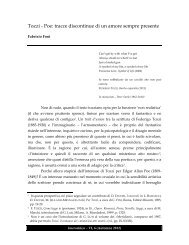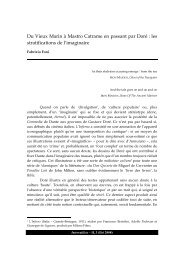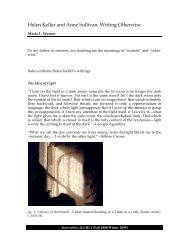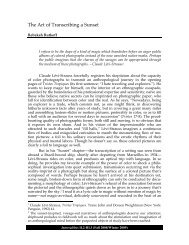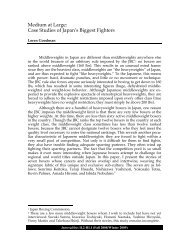The Tabula (not so) Rasa: La Monte Young's Serial Works ... - Cipa
The Tabula (not so) Rasa: La Monte Young's Serial Works ... - Cipa
The Tabula (not so) Rasa: La Monte Young's Serial Works ... - Cipa
You also want an ePaper? Increase the reach of your titles
YUMPU automatically turns print PDFs into web optimized ePapers that Google loves.
46 Jeremy Grimshaw<br />
occasion, the cowboy <strong>so</strong>ngs of his childhood. 24 <strong>The</strong> Bb at the center of the Trio is <strong>not</strong><br />
simply a line, but a timeline, on which Young charts his per<strong>so</strong>nal and musical life. 25<br />
A Historiographically Speculative Postscript<br />
In addition to suggesting a certain inextricability of form and content, compositional<br />
practice and biography, and, ultimately, acoustics and cosmology, the foregoing<br />
analysis of the Trio for Strings seeks to draw together two seemingly disparate compositional<br />
schools, namely minimalism and serialism. <strong>The</strong> extent and nature of<br />
Young’s twelve-tone practice in this work, and the relationship between his approach<br />
to dodecaphony and his adoption of the extreme durational parameters as<strong>so</strong>ciated<br />
with minimalism, points up a historiographical entanglement worthy of further recognition<br />
and examination. I close with a short and propaedeutic discussion in this<br />
direction.<br />
It comes as no surprise that the stylistic juncture the Trio represents has <strong>not</strong><br />
drawn more attention in the literature, for, despite the Trio’s innovation and presumed<br />
influence, it has circulated almost exclusively in bootleg copies and has never<br />
been recorded or published commercially. 26 <strong>The</strong> hour-long piece’s <strong>not</strong>oriety thus has<br />
owed largely to word-of-mouth accounts of occasional performances, which accounts<br />
assuredly have conveyed, primarily, the astonishing length of the work’s constituent<br />
tones, chords, and intervening silences rather than the compositional principles on<br />
which those configurations of tones and rests are based. 27 Furthermore, although<br />
Young composed the Trio in 1959 in California, the work received its public premiere<br />
in New York City in 1962, more than two years after Young had abandoned serialism<br />
as a compositional method—and by which time Young had distanced himself substantially<br />
from the academic environment of serial composition and had become one<br />
of the most infamously enigmatic figures in the Downtown New York avant-garde<br />
scene.<br />
While Young has generally been regarded as a father-figure for the minimalist<br />
movement in music, and for experimental music in general, <strong>so</strong>me writers recently<br />
have called the influence of Young’s early compositions into question. While recognizing<br />
the strong case for direct stylistic influence on Terry Riley and Pauline<br />
Oliveros, both classmates of Young’s at Berkeley, Keith Potter ultimately concludes<br />
that, in the short term, the Trio itself had little direct impact on other minimalist<br />
composers of the time, in terms of influencing their approach to compositional craft. 28<br />
Glass doesn’t remember ever hearing the Trio, Potter observes, while Steve Reich re-<br />
24 It is no accident that Young derives the fundamental tones of his Dream House installations<br />
from the 60Hz Bb of the electrical grid; in fact, when setting up installations in Europe,<br />
Young adjusts his frequencies <strong>so</strong> that they fall within the harmonic series of a fundamental<br />
derived from the 50 Hz European electrical grid.<br />
25 More recently, the Bb drone has taken on even more cosmic significance for Young: he<br />
likes to think of his drone as an octave harmonic of the “Bb” fundamental apparently emitted<br />
(in an almost unimaginably low transposition) by a black hole. See Whitehouse, accessed at<br />
.<br />
26 A curious edition of the Trio, printed on pocket-score-sized, newsprint-grade paper, with a<br />
translucent overlay of a photograph of the composer, was published in the 1960s by the<br />
Fluxus group; few of these scores survive, and at any rate performers wishing to play the<br />
piece today must contact the composer directly to obtain parts and permissions.<br />
27 One <strong>not</strong>able exception is the postminimalist composer David <strong>La</strong>ng, co-founder of the Bang<br />
On A Can organization and Cantaloupe Music. <strong>La</strong>ng has described his discovery of the Trio<br />
as a pivotal moment in his development as a composer, having procured at <strong>so</strong>me point in his<br />
early career a bootleg copy of the score; in his enthusiasm for the piece, and in the absence of<br />
available recordings, he entered the piece into a music <strong>not</strong>ation computer program in order<br />
to hear it played back in MIDI format (<strong>La</strong>ng).<br />
28 Oliveros was one of the composition students present at the private Berkeley premiere of<br />
the Trio; Riley did <strong>not</strong> attend the premiere, but later became a classmate—and, originally,<br />
<strong>so</strong>mething of a devotee—of Young.



